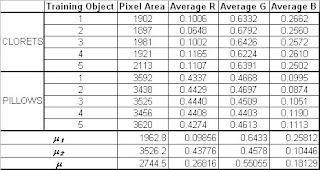This activity is related from the previous activity, Activity 14. Two classes from the pattern recognition activity was chose to be used in this activity. The Clorets and the Pillows classes will be the classified by applying the Linear Discriminant Analysis or LDA.
Like the Pattern Recognition, the purpose of LDA is to classify objects into groups according on a set of features that describe the object. Again, we need a training set with their features which will represent the predetermined groups.
The LDA process was comprehensively explained on http://people.revoledu.com/kardi/tutorial/LDA . The procedure can be explained also by the code made for this activity.
clorets_train = fscanfMat('clorets_train.txt');
clorets_test = fscanfMat('clorets_test.txt');
pillows_train = fscanfMat('pillows_train.txt');
pillows_test = fscanfMat('pillows_test.txt');
train = [clorets_train; pillows_train];
test = [clorets_test; pillows_test];
u1 = [mean(clorets_train(:,1)), mean(clorets_train(:,2)), mean(clorets_train(:,3)), mean(clorets_train(:,4))];
u2 = [mean(pillows_train(:,1)), mean(pillows_train(:,2)), mean(pillows_train(:,3)), mean(pillows_train(:,4))];
u = [mean(train(:,1)), mean(train(:,2)), mean(train(:,3)), mean(train(:,4))];
x01 = [clorets_train(1,:) - u; clorets_train(2,:) - u; clorets_train(3,:) - u; clorets_train(4,:) - u; clorets_train(5,:) - u];
x02 = [pillows_train(1,:) - u; pillows_train(2,:) - u; pillows_train(3,:) - u; pillows_train(4,:) - u; pillows_train(5,:) - u];
n1 = 5;
n2 = 5;
c1 = (x01'*x01)/n1;
c2 = (x02'*x02)/n2;
for r = 1:4
for s = 1:4
C(r, s) = (n1/(n1 + n2))*(c1(r, s) + c2(r, s));
end
end
invC = inv(C);
P1 = n1/(n1 + n2);
P2 = n2/(n1 + n2);
P = [P1; P2];
for k = 1:(n1 + n2)
f1(k) = u1*invC*test(k,:)' - (1/2)*u1*invC*u1' + log(P(1));
f2(k) = u2*invC*test(k,:)' - (1/2)*u2*invC*u2' + log(P(2));
end
f = [f1, f2];
The object with maximum f1 will be assigned to class of Clorets while the object with maximum f2 will be assigned to class Pillows.
The table below shows the corresponding feature vector of each sample from each class. The calculated mean feature for each class and the global mean vector was shown in the table.
 The table below shows the results.
The table below shows the results.
 The values of the discriminant function obtained are very large. This is due to the large discrepancy between the pixel area and the normalized chromaticity values which were used as featured vector. However, it can be observed that the difference between the two discriminant function were so small.
The values of the discriminant function obtained are very large. This is due to the large discrepancy between the pixel area and the normalized chromaticity values which were used as featured vector. However, it can be observed that the difference between the two discriminant function were so small.
I will grade myself 10/10 for completing this activity. I was able to implement the Linear Discriminant Analysis thus I was able to classify objects to their expected class. I want to acknowledged Gilbert for helping me finish this activity.
Like the Pattern Recognition, the purpose of LDA is to classify objects into groups according on a set of features that describe the object. Again, we need a training set with their features which will represent the predetermined groups.
The LDA process was comprehensively explained on http://people.revoledu.com/kardi/tutorial/LDA . The procedure can be explained also by the code made for this activity.
clorets_train = fscanfMat('clorets_train.txt');
clorets_test = fscanfMat('clorets_test.txt');
pillows_train = fscanfMat('pillows_train.txt');
pillows_test = fscanfMat('pillows_test.txt');
train = [clorets_train; pillows_train];
test = [clorets_test; pillows_test];
u1 = [mean(clorets_train(:,1)), mean(clorets_train(:,2)), mean(clorets_train(:,3)), mean(clorets_train(:,4))];
u2 = [mean(pillows_train(:,1)), mean(pillows_train(:,2)), mean(pillows_train(:,3)), mean(pillows_train(:,4))];
u = [mean(train(:,1)), mean(train(:,2)), mean(train(:,3)), mean(train(:,4))];
x01 = [clorets_train(1,:) - u; clorets_train(2,:) - u; clorets_train(3,:) - u; clorets_train(4,:) - u; clorets_train(5,:) - u];
x02 = [pillows_train(1,:) - u; pillows_train(2,:) - u; pillows_train(3,:) - u; pillows_train(4,:) - u; pillows_train(5,:) - u];
n1 = 5;
n2 = 5;
c1 = (x01'*x01)/n1;
c2 = (x02'*x02)/n2;
for r = 1:4
for s = 1:4
C(r, s) = (n1/(n1 + n2))*(c1(r, s) + c2(r, s));
end
end
invC = inv(C);
P1 = n1/(n1 + n2);
P2 = n2/(n1 + n2);
P = [P1; P2];
for k = 1:(n1 + n2)
f1(k) = u1*invC*test(k,:)' - (1/2)*u1*invC*u1' + log(P(1));
f2(k) = u2*invC*test(k,:)' - (1/2)*u2*invC*u2' + log(P(2));
end
f = [f1, f2];
The object with maximum f1 will be assigned to class of Clorets while the object with maximum f2 will be assigned to class Pillows.
The table below shows the corresponding feature vector of each sample from each class. The calculated mean feature for each class and the global mean vector was shown in the table.
 The table below shows the results.
The table below shows the results. The values of the discriminant function obtained are very large. This is due to the large discrepancy between the pixel area and the normalized chromaticity values which were used as featured vector. However, it can be observed that the difference between the two discriminant function were so small.
The values of the discriminant function obtained are very large. This is due to the large discrepancy between the pixel area and the normalized chromaticity values which were used as featured vector. However, it can be observed that the difference between the two discriminant function were so small.I will grade myself 10/10 for completing this activity. I was able to implement the Linear Discriminant Analysis thus I was able to classify objects to their expected class. I want to acknowledged Gilbert for helping me finish this activity.

No comments:
Post a Comment